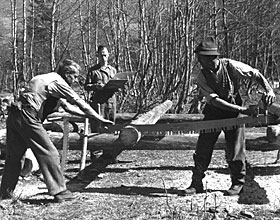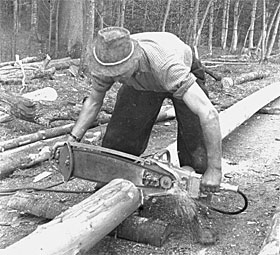History of the chainsaw
Date Posted: 9 April 2015
 |
| Fig. 1 - Hand sawing with the forest superintendent looking on ... |
 |
| Fig. 2 - One of the first one-man chainsaws |
| Photos: Archives WSL |
The first chainsaws were developed in the 1920’s. The development of the motorised saw led to an increase in timber production comparable to that which occurred when the non motorised saw took the place of the axe.
The history of forest work runs parallel to that of the human race. For thousands of years the forest was linked to the development, problems and evolution of civilisation. In time the dark, threatening forest thicket became a useful timber supplier. The forest was tamed, so that today it is not only an important economic factor, but it also fulfils various functions such as protection or recreation.
For hundreds of years the lumberjack’s job was one of the lowliest, at the bottom of the social ladder. This only changed with the introduction of the modern chainsaw. This improved the lumberjack’s social prestige and self esteem. A disdained day labourer became a respected machine operator and specialist.
From the axe to the saw







